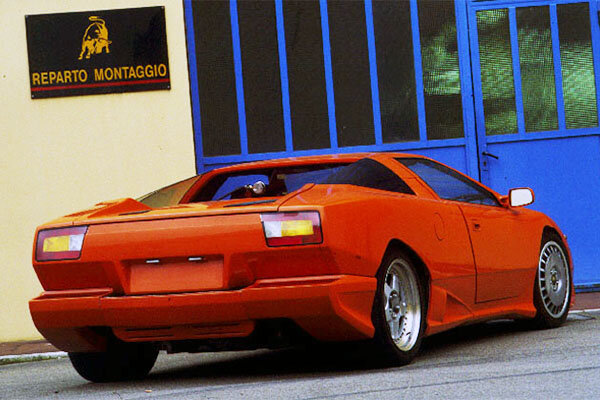Guide: Chrysler's Big Italian Failure - a Historical & Technical Appraisal of the Lamborghini P140
/BACKGROUND
In early 1987, Lamborghini started work on a replacement for the Jalpa.
Although the Jalpa had only been launched in 1981, it was little more than a facelifted version of the Silhouette.
The Silhouette had gone out of production in 1978 when Automobili Lamborghini was declared bankrupt. It had been launched in 1976 as a targa-topped two-seat version of the Urraco which could trace its roots back to the late 1960s.
A clean sheet replacement was therefore overdue and thanks to Lamborghini’s revival under the excellent management of Patrick and Jean-Claude Mimram, the company was finally in a position to create a successor.
Like the Jalpa, the new Lamborghini (codenamed P140) would have its sights fixed squarely on products from Maranello and Stuttgart. There was also a new generation of Japanese sports cars to consider, particularly the forthcoming Honda NSX.
In addition to the P140, Lamborghini were working on a replacement for the Countach which meant R&D resources were initially stretched to the limit.
However, soon after the P140 programme began, Chrysler purchased Automobili Lamborghini from the Mimram Group. The takeover was completed in April 1987 and netted the Mimram’s a reported $25m from their original $3m investment.
Chassis
The P140 featured a bonded aluminium monocoque chassis with a 2522mm wheelbase (71mm longer than the outgoing Jalpa).
Suspension was via double wishbones with coil sprung damper units all round and anti-roll bars at either end.
Brakes were ventilated four-wheel discs.
Various styles of 18-inch wheels were trialled.
Compared to the Jalpa, track was 92mm wider at the front and 28mm wider at the rear.
ENGINE / TRANSMISSION
For reasons of compliance, efficiency and output, the Paolo Stanzani-designed V8 engine originally commissioned for the Urraco was not a consideration for Lamborghini’s next generation junior model.
An entirely new four-litre all-alloy V10 was created instead. It featured dual overhead camshafts, four valve cylinder heads and displaced 3961cc.
Electronic Magnetti Marelli engine management was employed.
With a compression ratio of 10.5:1, some impressive output figures were realised very early on. Lamborghini quoted a peak output of 372bhp at 7000rpm and 288lb-ft at 5500rpm.
These numbers compared favourably with anything Ferrari, Maserati or Porsche had to offer and would almost certainly have made the P140 the best performer in its class.
A new six-speed manual gearbox was installed.
BODYWORK
When it came to bodywork for the new model, proposals from Marcello Gandini, Bertone and the Chrysler Design Center were considered.
Lamborghini ultimately went with Marcello Gandini who had a long history with the marque having designed the Miura, Espada and Countach (among many others).
Gandini created a two-door targa with predominantly carbonfibre body panels.
The overall profile was quite angular and even the wheelarches incorporated nearly straight lines.
However, the design never got beyond the initial prototype stage, so considerable refinements would most likely have been made by the time the P140 was placed on sale.
Overall, the new machine was 60mm shorter, 40mm wider and 80mm taller than the Jalpa.
INTERIOR
Inside, the P140 was a complete departure from its predecessor.
Tunnelled gauges were a particular feature: directly behind the three-spoke steering wheel was a tachometer and speedo, each of which was flanked by a smaller gauge on either side. Another four small instruments angled towards the driver were located in the middle of the dash above the well laid out centre console which contained the switchgear, stereo and heater/cooling vents.
The dash and door panels were typically upholstered in contrasting two-tone material.
WEIGHT / PERFORMANCE
Despite its bigger engine, the P140’s extensive use of aluminium and carbonfibre meant it tipped the scales at 224kg less than the Jalpa (1286kg).
Top speed was 183mph and 0-62mph took 4.8 seconds.
PROTOTYPES
The first P140 was completed in 1989 and three were built in total.
The first was painted orange and tested extensively at Nardo.
P140 number two was painted red, but was just a rolling chassis.
The third and final P140 was white and is today on display at the Automobili Lamborghini museum.
The original running P140 was later transformed into the Lamborghini Cala concept by Ital Design.
CHRYSLER PULLS THE PLUG
Although the P140 was close to production-ready with a planned launch set for 1992, Chrysler cancelled the programme in the final stages of development. The early nineties recession had slashed demand for high performance exotics and with hundreds of unsold Diablos piling up at the factory, the decision was understandable.
Chrysler had hoped to sell around 1000 P140s each year.
NEW OWNERS FOR AUTOMOBILI LAMBORGHINI
Having suffered some huge financial losses, Chrysler sold Automobili Lamborghini in 1994.
The new owners were Malaysian investment group Mycom Setdco and Indonesian group V Power Corporation. They jointly formed the Bermuda-registered holding company, Megatech.
In 1995, the P140-based Cala was unveiled.
Unfortunately, the Cala project was also dropped owing to the considerable cost involved in bringing it to market.
Text copyright: Supercar Nostalgia
Photo copyright: Lamborghini - https://www.lamborghini.com































